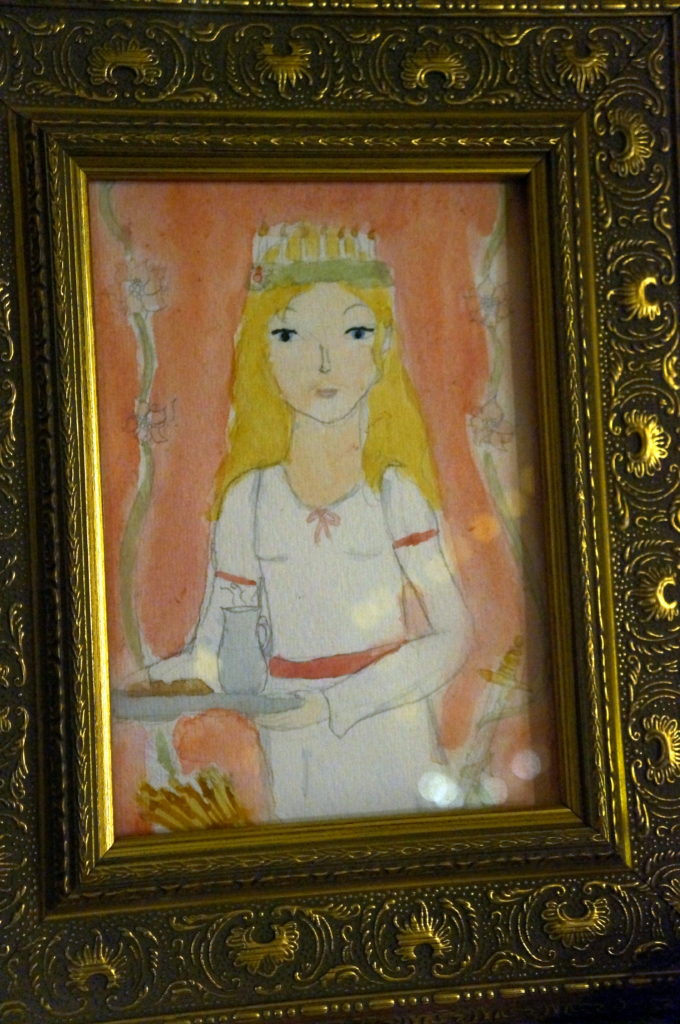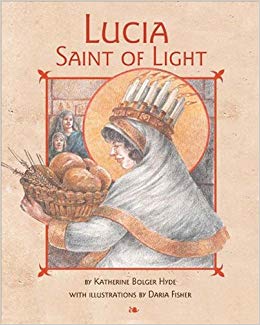Feast Day: December 13
I’d love to know the history of how a Roman martyr of the early Church became the beloved saint of Scandinavia (I think it’s something like distract the medieval locals’ winter solstice pagan celebration with a surprisingly fitting Catholic feast). But it was meant to be: the feast day of a saint whose name means “light” happens to fall on one of the shortest days of the year, with a 3:00 pm sunset after about six hours of sunlight. It’s no surprise the Swedes developed a unique celebration around her feast. I would be needing a little cheering up by then, too. Even in the PNW (with only a couple hours longer of daylight than Scandinavia), I get up the Christmas lights as fast as I can after Thanksgiving.
Though I am a little Swedish (8% to be exact), I didn’t start celebrating the feast of St. Lucia until I had children. It was something my older girls initiated after reading the Kirsten American Girl books, in which the Swedish immigrant Kirsten has the honor of donning the traditional white dress with red sash and candled-wreath for the feast. I think my girls were most interested in the dangerous, but beautiful costume. But we were also really missing Oma and Opa, my grandparents who at the time were 3,000 miles away. None of the German and Swedish traditions which their families may have known about in Europe successfully made it to America. In other parts of the States, European communities kept more of these traditions alive, but often when immigrants came to the PNW, they were loner homesteaders with little to no connections. The only Swedish piece of my family’s history that I retained was the name. The December after my Opa passed away, it somehow became more important to celebrate this feast, even though I never celebrated it with him. But I knew he was proud of his Swedish heritage; his Lindgren crest hung in the entryway of their house. So I was pleased that my children had taken an interest, and over the next few years, we formed our own little St. Lucia celebration.
When I was little, my mom made Swedish bread for breakfast on Christmas morning. It was just a recipe she got from a generic cookbook: a sweet, braided bread with different fillings. My kids and I now make this for St. Lucia’s day, along with an easy (but it IS Swedish!) dinner menu of Svenska Köttbullar (meatballs, creamy potatoes, and lingonberry; also known as IKEA’s dinner of choice).

On the morning of St. Lucia Day, traditionally a daughter wakes up the house with coffee, sweet bread, and songs. This job has rotated among our girls (and so far, once our girls become teenagers, they frown on waking up early). Our St. Lucia costume is a converted Princess Leia costume. We’re not quite sure how to manage the candled-wreath (or whether that’s to code?), but we have a gold and red ribboned wreath to wear instead. She can have attendants, other girls who wear white with tinsel around their waists and heads, or boy-attendants (called “starboys”) who wear white, have cone-hats, and carry stars. Our boys haven’t been too keen on this yet.
Even without the delicious sweet bread and Svenska Köttbullar (which is really fun to say), the story of St. Lucia and the significance of this young woman who was a “light in the darkness” as we are all called to be, is certainly worth at least a prayer or meal-time mention. This little light of St. Lucia reminds us of the Light we await during the Advent season. It’s another step in preparing our hearts to house Our Lord.
Swedish bread
(my part-Swedish mom’s recipe… so it’s legit, people… no, not really, she got it out of a cookbook, but it’s GOOD)
- 2 cups sour cream
- 2 packages active dry yeast
- ½ cup warm water
- ¼ cup butter or margarine
- 1/3 cup sugar
- 2 tsp. salt
- 2 eggs (or 3, if you use gluten-free flour)
- about 6 cups flour (this also works with gluten free 1-to-1 substitute flour)
- Heat sour cream over low heat just until lukewarm. Dissolve yeast in warm water. Stir in sour cream (make sure not too warm). Stir in ¼ cup butter (softened), sugar, salt, eggs, and 2 cups flour. Beat until smooth. Mix in remaining flour to make dough easy to handle.
- Turn dough onto well-floured board. Knead until smooth (about 10 minutes). Place in greased bowl greased-side up. Cover. Let rise in warm place until double (about an hour). Heat oven to 375. Punch dough down. Divide into three equal parts. Roll each part into a rectangle 15 x 6 inches. Placed on a greased baking sheet (unless non-stick). With scissors make 2-inch cut at ½ inch intervals. Fill it. Criss-cross strips over filling.
- Bake 15-20 minutes or until golden brown. While warm brush with butter or drizzle canes with thin icing.

This is a great book to have around for St. Lucia Day. It explains the traditions of the day, along with the true story of the saint.
